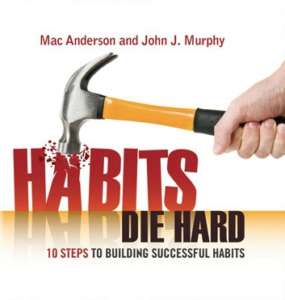

“We are all creatures of habit and if you make good habits, good habits will make you.”
Due to the power of our subconscious minds (a k a “automatic thinking”), good and bad habits become ingrained through repeated actions and thoughts. If we want to break habits like drinking too much, eating too much, worrying too much, being overly defensive or judgmental, or a host of others, our mental mechanisms need to change. Discover the secrets for exchanging bad habits for good in the smart and accessible Habits Die Hard, by Mac Anderson and John J. Murphy, which shares 10 easy-to-follow steps to meet this rewiring challenge:
1. IDENTIFY AND DEFINE THE HABIT
We cannot solve a problem we do not understand. Therefore, it is not just the behavior we must identify and define. We must identify “the underlying assumptions, perceptions, thoughts and beliefs leading to the behavior.”
2. FEEL THE HABIT—DO NOT RESIST
The second step is to “accept and own the habit…let it in to let it out.” Take responsibility for the behavior and the underlying thinking that gives it life. A good strategy is to focus on one habit at a time: “identify the habit, clearly define it, and then seek understanding by contemplating your feelings and the thoughts behind it.” It’s important to “listen to your heart. It has intelligence that intellect does not understand.”
3. TAKE MEASURE—KNOW THE SCORE
As Anderson and Murphy put it, “To manage effectively, we must measure effectively…we must keep score to know the score.” Think about how often your habit manifests itself and if there are patterns you can identify.
4. ASK WHY?—BE CURIOUS
“The next step to changing habits is analysis. It is here that we seek to know the relationship between inputs and outputs, causes and effects.” This the big WHY? question. Identifying the causes and triggers of our negative habits is a major hurdle, as so many of our automatic thoughts are negative. Don’t be afraid and let excuses creep in.
5. IMAGINE AND VISUALIZE THE CHANGE
A powerful tool that successful people employ is the ability to visualize where they want to be in the future. This chapter discusses the fact that alternatives to bad habits DO exist. There is choice. An effective management technique: identify at least three solutions to every problem. When you are habit-breaking, imagine and visualize three alternatives to every habit you want to change.
6. ASSESS THE RISK
Acknowledge that fear is a powerful “de-motivator.” “I can’t…if only…yeah, but”—fear keeps the excuses coming. At this point in the process, we are dealing with the risk of leaving the comfort zone that a habit affords, the risk of the unknown. We need to ask, What is the actual risk of letting go? Is there a better life on the other side of that risk? Could the risk be minimal versus the reward?
7. BE THE CHANGE
Here we face the challenge of staying in the now. Don’t let the games your mind will play distract you from the commitment at hand. Anderson and Murphy suggest, “Your behavior is now. Your habits are now. Let the past go, and think in terms of be, not become.” Be focused and seek “better, not best.”
8. FEEL THE CHANGE
“Feeling good about the changes we are making is essential to sustaining them,” so when you succeed in changing an unwanted habit, allow yourself to fully experience how great a new pattern of behavior makes you feel.
9. GIVE THANKS AND APPRECIATION
Now is the time for “awareness, presence, and wisdom” and giving thanks for our very ability to learn, change, adapt, and strive for the rewards of better habits.
10. MAINTAIN THE GAIN
Finally, how to sustain the course you have chosen and achieved? Anderson and Murphy are a font of techniques to manage your gains, including the concept of “poka-yoke,” Japanese for “mistake-proofing,” or outsmarting your potential mistakes. If you don’t keep junk food in the kitchen, you can’t eat it!—poka-yoke is that basic and effective.



